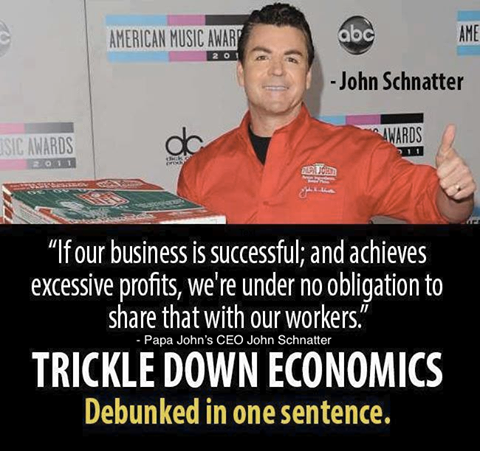I found myself involved in a Facebook discussion this morning with a couple of really smart cyber-friends concerning what I would consider to be “a capitalist conundrum.”
The discussion was triggered by the meme to the left. It’s basically a slam against “trickle-down” economics, or the idea that if we get out of the way of the rich, that their success will inure to the benefit of the rest of us poor saps. That theory, while it might sound logical, has not shown to be a very viable one in practice.
But the discussion centered more around a comment that implied that there is a disconnect between profits and wages…that the only thing that does and should determine wages are needed skills. That there is a market for needed skills and that market sets the price for said skills. How those skills are then employed, and to what success, is irrelevant to their price.
And that would be correct, according to a standard capitalistic theory of economics. The purpose of the business enterprise is to maximize profits for shareholders, or owners, period. And if it can exploit workers in the process of achieving that purpose, then fine, go right ahead. After all, the workers can opt for another job in which the market for their skills will pay them more, correct?
Well, maybe.
In practice, when one is forced to shop their skills in the marketplace, the results are often not so stellar. That’s why the government often has to extend and re-extend unemployment benefits…to the chagrin of the same business owners whose exploitation is causing the need for extension.
After all, what does a business enterprise really consist of? A corporation does not exist in physics, only in law. The activity of a corporate business enterprise is that of the flesh and blood humans that pledge allegiance to it, either as owners, employees, or both. The owners of a corporation are no different in that regard than the factory-line workers.
Let’s put it this way, even in this age of increasing automation, if you take the humans out of the enterprise, there is no enterprise.
Now, if those humans work together efficiently and effectively to the success of the enterprise, why is it that only the owners should enjoy the benefits of that success? Well, because capitalism tells us that things are just that way…
But that doesn’t make it right, or even reality.
The problem with this capitalist conundrum is that if in the pursuit of profits, workers are exploited in the name of hoarding profits and building value solely for owners (a situation that has been occurring at increasing levels over the last 40 years), then the system breaks down. Workers aren’t as motivated, perhaps rightly pissed. Strikes ensue. Government has to step in with regulation. There are less and less ordinary folks, workers in their own right, able to buy the products or services of corporate America. A recession occurs, maybe even a depression. Revolutionary impulses are fomented. Shots are fired, wars begin, society crumbles.
I may be being a bit over dramatic, but all this has happened before, hasn’t it?
The idea that business enterprises should be able to pursue profits, and exploit workers in the process, without any government interference, lies at the heart of neoliberal capitalist philosophy. It also lies at the heart of the problem we’re now in with inequality rising to never before seen levels.
It is simply not reality to say that wages and profits are disconnected. It might be correct according to a certain brand of economic philosophy, but it is not real world reality. Corporate profit generation requires people and the resources of the planet in which we all inhabit…profits are not disconnected from those things.
That is a capitalist conundrum and we need to be able to escape from its impact blinding influences.
My new book, The Impact Revolution, is now live on Amazon. It was written to inspire empathy, to inspire connection. It was written to inspire the positive impacts that flow from empathy and connection. It was written to inspire an acceptance of the idea that we’re really all in this together.


Leave a Reply